Union Minister of External Affairs, Dr. S. Jaishankar, expressed deep satisfaction over the progress of development projects in several Gujarat villages adopted under the Sansad Adarsh Gram Yojana (SAGY). On a recent visit to his home state, he highlighted how targeted initiatives in rural areas were translating into tangible improvements in people’s lives—particularly in sectors like education, healthcare, water management, and digital access.
The villages in question, adopted by Jaishankar under SAGY, are located in Gujarat’s Navsari district, part of his Rajya Sabha constituency. The Sansad Adarsh Gram Yojana, launched in 2014, aims to encourage Members of Parliament to adopt villages and transform them into model communities through a mix of government schemes, community participation, and innovative practices.
Improvements on the Ground
During his visit, Jaishankar took stock of the ongoing and completed projects in the adopted villages. One of the key achievements highlighted was the successful implementation of clean drinking water systems, reducing the burden on women and children who previously had to walk long distances for water. The installation of water filtration units, powered by solar energy, has made potable water readily accessible, helping improve overall public health in the region.
Another area of transformation has been education. Smart classrooms equipped with digital learning tools have been established in local schools, with a visible uptick in student attendance and enthusiasm. In his remarks, Jaishankar shared how these initiatives are helping bridge the rural-urban divide. “Education is empowerment, and it’s encouraging to see children in these villages gaining exposure to modern learning methods. We’re sowing the seeds for a better future,” he said.
Healthcare Access Enhanced
Healthcare too has seen noticeable upgrades. Mobile medical vans, equipped to offer basic diagnostic and treatment services, now visit the villages regularly. Telemedicine centers have been set up, connecting local residents with doctors from urban hospitals. Maternal and child health indicators have shown improvement, and there has been a marked increase in health awareness among villagers.
During his visit, Jaishankar interacted with several beneficiaries of these initiatives. A local resident, Meena Patel, expressed gratitude, saying, “Earlier, we had to travel over 15 kilometers for any kind of medical checkup. Now, we have doctors and medicine available right here.”
Empowering Through Technology and Skill Development
Digital infrastructure has also been expanded, with the launch of village Wi-Fi zones and digital literacy campaigns. Young villagers are being trained in computer literacy, online services, and digital payments. These skill-building initiatives have already started bearing fruit, with some youths finding remote work opportunities and even launching small online ventures.
Women’s self-help groups (SHGs) in the villages have also been strengthened. With the help of microfinance and training in basic accounting and marketing, these SHGs are involved in producing handicrafts, organic products, and even eco-friendly packaging materials. The income from these ventures is helping raise the standard of living for many families.
A Model for Replication
Dr. Jaishankar’s involvement has extended beyond symbolic gestures. Local officials noted that his frequent follow-ups and coordination with central departments ensured that administrative bottlenecks were swiftly resolved. In his address to a gathering of villagers, he emphasized the importance of self-reliance and active community participation in sustaining development.
“These villages are not just benefitting from top-down schemes—they’re thriving because the people here are taking ownership of their progress. That is what makes them models for replication,” he noted.
Future Plans
Looking ahead, Jaishankar mentioned plans to introduce renewable energy solutions on a larger scale in the villages. Pilot projects for solar-powered irrigation pumps and biogas plants are in the pipeline, aimed at making agriculture both sustainable and profitable.
Additionally, the push for more employment-generating initiatives—particularly in eco-tourism and agro-processing—will be central to the next phase of development.
Conclusion
The transformation of these villages stands as a testament to what focused leadership and sustained community involvement can achieve. Dr. S. Jaishankar’s deep engagement with grassroots issues, coupled with his global experience, is setting a precedent in how rural development can be approached with vision, accountability, and inclusiveness. The progress in Gujarat’s adopted villages may well become a model for others to follow—showing that change begins with commitment, and that commitment can create lasting impact.

